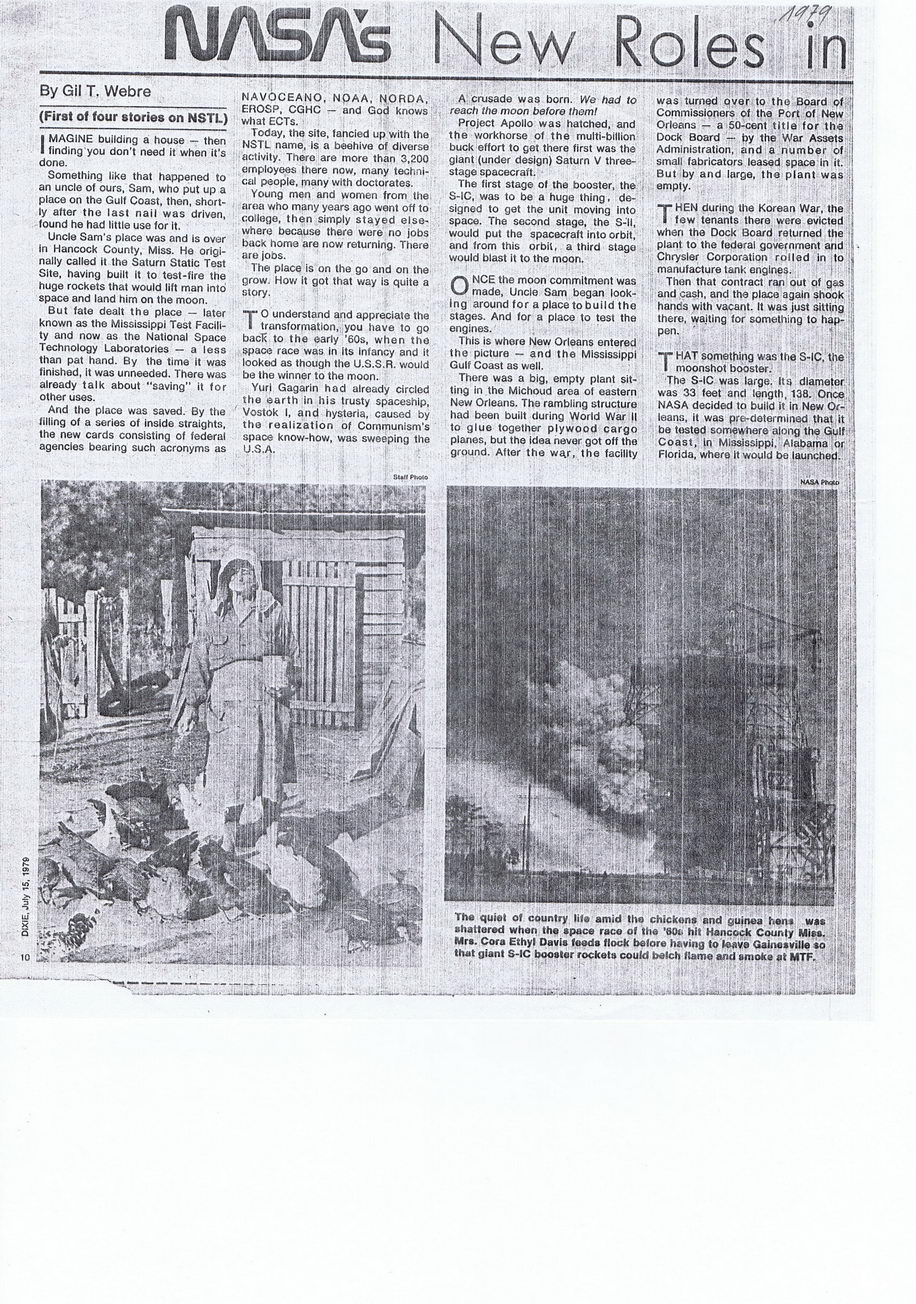This text was obtained via automated optical character recognition.
It has not been edited and may therefore contain several errors.
By Gil T. Webre (First of four stories on NSTL) IMAGINE building a house ? then finding you don't need it when it?s done. Something like that happened to an uncle of ours, Sam, who put up a place on the Gulf Coast, then, shortly after the last nail was driven, found he had little use for it. Uncle Sam?s place was and is over in Hancock County, Miss. He originally called it the Saturn Static Test Site, having built it to test-fire the huge rockets that would lift man into space and land him on the moon. But fate dealt the place ? later known as the Mississippi Test Facility and now as the National Space Technology Laboratories ? a less than pat hand. By the time it was finished, it was urineeded. There was already talk about ?saving? it for other uses. And the place was saved. By the filling of a series of inside straights, the new cards consisting of federal agencies bearing such acronyms as NAVOCEANO, NQAA, N|ORDA, EROSP, CGHC ? and God knows what ECTs. ;? Today, the site, fancied up with the NSTL name, is a beehive of diverse activity. There are more than 3,200 employees there now, many technical people, many with doctorates. Young men and women from the area who many years ago went off to college, then simply stayed elsewhere because there were no jobs back home are now returning. There are jobs. The place is on the go and on the grow. How it got that way is quite a story. M O understand and appreciate the transformation, you have to go back to the early ?60s, when the space race was in its infancy and it looked as though the U.S.S.R. would be the winner to the moon. Yuri Gagarin had already circled the earth in his trusty spaceship, Vostok I, and hysteria, caused by the realization of Communism?s space know-how, was sweeping the U.S.A. Stalf Photo A crusade was born. We had to reach the moon before them! Project Apollo was hatched, and the workhorse of the multi-billion buck effort to get there first was the giant (under design) Saturn V three-stage spacecraft. The first stage of the booster, the S-IC, was to be a huge thing, designed to get the unit moving into space. The second stage, the S-li, would put the spacecraft into orbit, and from this orbit, a third stage would blast it to the moon. ONCE the moon commitment was made, Uncie Sam began looking around for a place to build the stages. And for a place to test the engines. This is where New Orleans entered the picture ? and the Mississippi Gulf Coast as well. There was a big, empty plant sitting in the Michoud area of eastern New Orleans. The rambling structure had been built during World War II to glue together plywood cargo planes, but the idea never got off the ground. After the wau\ the facility was turned over to the Board Commissioners of the Port of New ; Orleans ? a 50-cent title for the j Dock Board ? by the War Assets j Administration, and a number of j small fabricators leased space in it. ? But by and large, the plant was.-j empty. THEN during the Korean War, the few tenants there were evicted when the Dock Board returned the plant to the federal government and Chrysler Corporation rolled in to manufacture tank engines. j Then that contract ran out of gas and cash, and the place again shook hands with vacant. It was just sitting there, wajting for something to happen. ' ; |M;j THAT something was the S-IC, the moonshot booster. - ; The S-IC was large. Its* diameter was 33 feet and length, 138. Once NASA decided to build it in New Orleans, it was prei-determined that it be tested somewhere along the Gulf Coast, in Mississippi,? Alabama ;6r Florida, where it would be launched !?! h-% l, "liiMf.'- i.* ?& The quiet of country life amid tho chickens and guinea heni was shattered when the space race of the ?60s* hit Hancock County Mies* Mrs. Cora Ethyl Davis feeds flock before having to leave Gainesville so that giant S-IC booster rockets could belch ISame and smoke at MTF.

Moolekamp, Frank 010